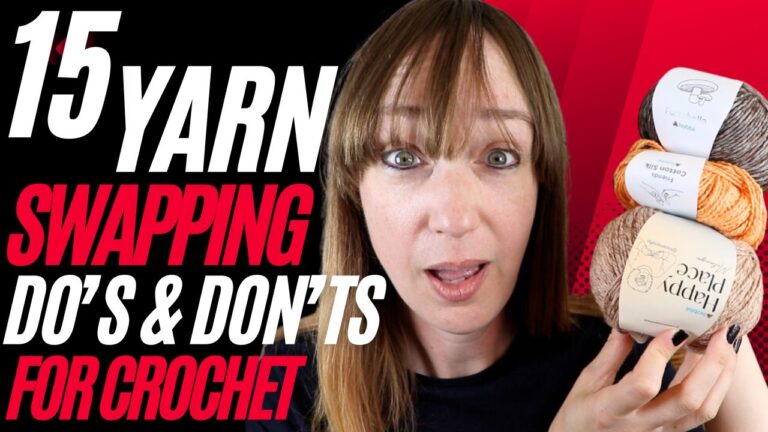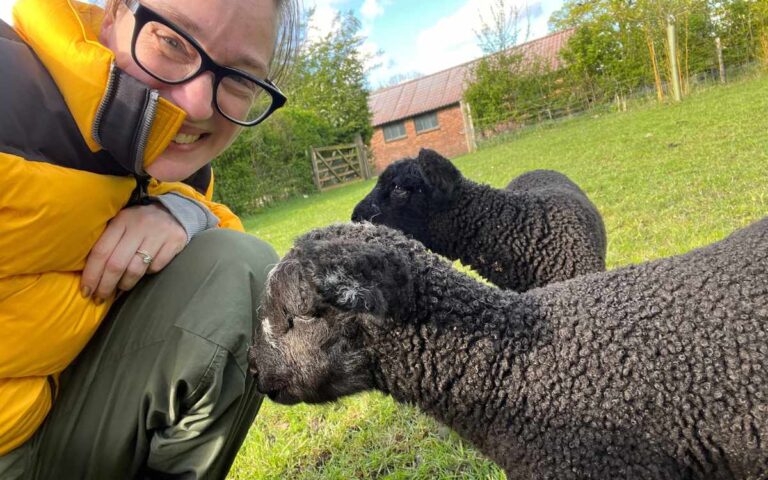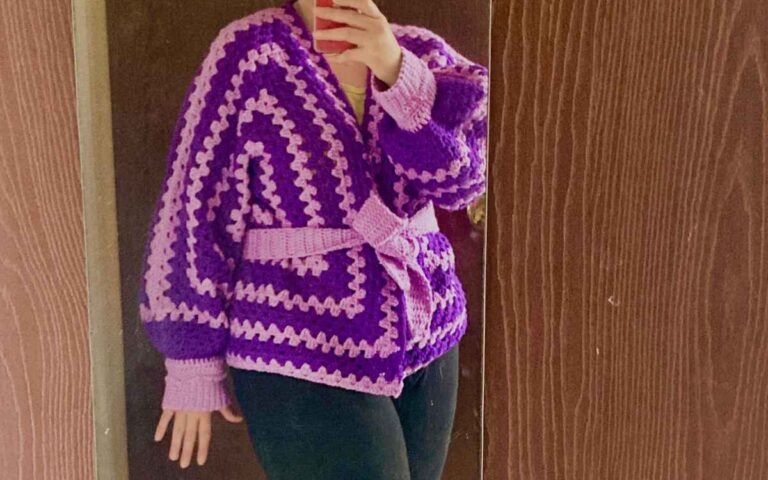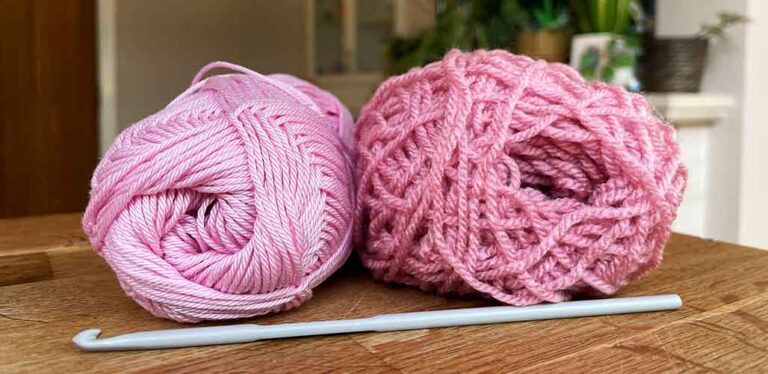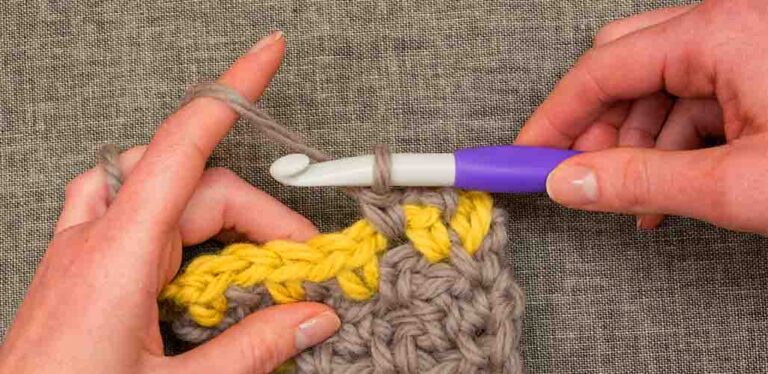Best Yarn For Crochet Sweaters

Choosing the best yarn for crochet sweaters makes all the difference. Getting the weight and texture right, and knowing that the finished result will be beautiful and long lasting, are under-appreciated parts of what makes crocheting your own wardrobe so satisfying.
I’ve used all kinds of yarns for making sweaters – some of which I bought specifically because the pattern called for them, and others I had found in thrift stores and they just seemed right for the job. There is no single yarn which is better for making sweaters than all the rest, but once you understand yarns’ different properties, you’ll be pretty sure to have an idea which type is right for your next project.
What is the best yarn for making sweaters?
There are hundreds, and possibly even thousands, of yarns suitable for making crochet sweaters. Online shopping means we’re no longer limited to the options stocked at our local stores – we can buy from national chains and independent makers all over the country, and even have specialist handmade yarns shipped to us internationally! Unsurprisingly then, there is no single yarn that is best for making sweaters. The right yarn for your project depends upon things like:
- The pattern
- Your budget
- Who’s going to wear it
- What color(s) you want
- Whether your want the sweater to have special properties like being extra warm, super durable, or machine washable
So I am going to recommend some specific yarns I have had great results with in the past, but I think it’s also more useful to talk about what to look for in sweater yarns. After all, your ideal sweater yarn and my ideal sweater yarn might not be the same! So whether you’ve already found some yarn you love and you’re wondering if it’s suitable for a sweater, or if you’ve got a sweater pattern lined up and you’re looking for a suitable yarn to make it from, hopefully you’ll know exactly what choice to make in five minutes’ time. Let’s go!
Making crochet sweaters: do I have to use the yarn specified in the pattern?
Most crochet patterns have been written with a specific yarn product in mind. Yarn manufacturers commission pattern designers to come up with patterns that use their products, and advertise them together, for example. Even amateur and hobbyist pattern writers will usually include notes of which yarn they used in the development of their patterns. Using the same yarn again is the easiest way to reproduce the same results they did. But, inevitably yarns sometimes stop being made, or aren’t available in your region, or you just don’t like something about them.
And when that happens, of course you can pick a different yarn! All you need to do is pick another yarn of the same weight, and check that the gauge is still correct.
Picking another yarn of the same weight
This is usually pretty straight forward – if your pattern calls for DK yarn, choose another DK yarn. If you’re feeling adventurous you can combine yarns though – for example instead of a worsted weight yarn you could use a skein DK yarn and a skein of single ply mohair yarn at the same time, for an extra soft and warm result.
Checking the gauge
If your pattern specifies a gauge (how many stitches and rows in a four inch square), make a sample square in your chosen yarn, to check if the gauge is still correct. Even two DK yarns can have different gauges. If your swatch is too big, try again with a smaller hook, and vice versa, until you get it right.
Patterns where gauge doesn’t matter
Some patterns (like the one in the video above) don’t specify a gauge because you simply add stitches and rows to the garment until the dimensions are correct for your body. These are the easiest patterns to recreate in different yarns – especially if this is your first sweater and you’re not confident adjusting for gauge yet.
Choosing the right fiber
Yarn comes in a huge range of natural and synthetic fibers, and some of those lend themselves better to making a sweater than others. Here are some of the most popular choices:
1. Wool
Humans have been making sweaters out of wool* for millenia, and for a reason. It’s warm, stretchy, breathable, gentle on skin, fast drying, doesn’t hold onto odors, renewable and visually beautiful. Besides the classic lamb’s wools and sheep’s wools, look out for more unusual choices such as merino, cashmere blends, alpaca and mohair.
On the downside, wool also tends to be among the most expensive yarns. It’s also the most vulnerable to shrinking if it accidentally ends up in the wrong washing cycle.
2. Cotton
Cotton yarns* are hard wearing and durable, and stand up better to being washed. In the past they were traditionally avoided for crochet sweaters because the results were too stiff and heavy to be comfortable. But modern cotton yarns are much softer and lighter. However, since cotton production is very environmentally damaging, some makers are turning away from it in favor of more sustainable options.
3. Bamboo
Bamboo yarns are rapidly gaining popularity* as a more sustainable, eco-conscious alternative to cotton. They are very smooth and light, meaning they drape nicely and make nice lightweight summer sweaters. However, they’re not the warmest choice for winter sweaters, and since they’re relatively unusual, you might not always be able to find the color you had in mind.
4. Acrylics
Acrylic yarns are by far the most widely sold and readily available*. They’re budget friendly and machine washable, which makes them a good choice for your first sweater, and for children’s sweaters.They also have the advantage of being more color fast if you want to make a sweater with bright contrasting stripes. On the downside, synthetic fibers can be less pleasant to wear, more prone to pilling, and less durable over time.
Yarn fibers to avoid
In general, I’m a big fan of experimenting with any yarn you want to for given any project. If you want to know how the results will look, then go find out! But, I’m still going to share some experiences which most definitely didn’t work out for me.
Firstly, really cheap acrylic yarns. Yes, buying the materials to crochet a sweater can be expensive, and choosing an acrylic yarn is a good way to keep your materials costs to a minimum. But don’t be seduced by the super cheap economy balls. They split and break so quickly that your finished garment is at serious risk of unraveling, and then all your money and effort has been lost anyway. A better way to save money on yarn is to buy up other peoples’ stashes from thrift stores, or look for end-of-dye-lot discounts online.
Secondly, avoid boucle yarns, which have lots of little loops along their length. I’d say this for most crochet projects in fact – those loops are going to get caught on your hook, and you will end up cursing your choice!
And finally careful when using contrasting colors. If you fancy a striped sweater, make up a small swatch in your chosen colors, and run it through whatever laundry method you’re planning to use for your sweater, to check the dyes don’t run!
Choosing the right yarn weight for sweaters
Once you’ve settled on the right fiber for your sweater, you’ll need to find a yarn made from it in the right weight. Some patterns stipulate what weight your yarn ought to be, but others – like granny hexagon sweaters or the pullover in the video at the top of this article – can be made in any weight of yarn. You just keep working as many stitches and/or rows as necessary until the dimensions are correct. So here’s a quick run down of yarn weights, and the pros and cons of each for sweater making.
- Lace weight (1 ply)
- Fingering weight (2 ply)
- Sport weight (4 ply)
- DK weight (8 ply)
- Worsted weight (10 ply)
- Bulky (12 ply and up)
Lace weight or 1 ply yarns
Also known as single ply. These yarns are so fine that you wouldn’t try to crochet a sweater from a single strand alone. But if you’re feeling adventurous, you could use a ball of 1-ply mohair or alpaca yarn together with a ball of 4 ply lambswool, to produce a sweater that combines the softness and insulating prowess of the former, with the substance and durability of the latter.
Fingering weight, or 2 ply
2 ply yarns are usually reserved for crocheting shawls. Some sweater patterns could be adapted for 2-ply yarn, but they will probably take a long time to make, unless they use very open and lacy stitches. A fun and more feasible option is to use two contrasting colors of 2-ply yarn at once, for a 4-ply sweater project.
3 ply yarns?
3 ply yarns do exist, but they are relatively few and far between. They would still take a long time to work into a sweater, and they are most commonly used for socks or baby garments. But if you’ve found some, they’re ideal for combining with single-ply alpaca and mohair yarns for warm but lightweight sweaters. Find a 4-ply pattern to follow, and check the gauge first – you might need to use a different hook size.
Sports weight, or 4 ply
Sports weight yarns* are among the most versatile for making crochet sweaters. 4 ply yarn lends itself equally to delicate and pretty lace stitches, 3D stitches like puffs and shells, and densely-worked opaque stitches for warm winter sweaters. 4 ply crochet sweaters are great everyday items which can be layered over t-shirts and under jackets. The only time I’d advise against them is for your first ever crochet sweater, because they can still be on the slow side to work up.
DK, or 8 ply
DK (which stands for ‘double knitting’) yarns * are overwhelmingly the most popular choice for making crochet sweaters. And that’s reflected in the abundance of crochet sweater patterns written for them. Their gauge is big enough that you won’t get dispirited by the speed of your progress, and the results are thick enough to be cosy, but not so bulky that you can’t get a coat over the top.
Worsted weight, or 10 ply
Also known as aran yarns. Depending on the fiber used and how tightly it has been twisted together, worsted weight yarns aren’t always thicker than DK yarns. They’re great for warm winter sweaters, and for making quick progress on hexagon cardigans.
Bulky and chunky yarns: 12 ply and up
Super bulky yarns have been growing in popularity over the years. They are especially popular with retailers selling kits that contain everything you need to make your own crochet sweater. The reason is simple: their gauge is huge and you’ll make progress quickly! Big yarns are fantastic for sweaters that make big statements, and they’re also less fiddly to work with, if you’re new to crochet.
My favorite yarns for making sweaters
Hopefully, you’ll be able to combine all the information above to make your own judgment about what type of yarn is best for your next crochet sweater. Then it’s just a case of finding a brand which makes it in the right color, and within your budget. But before I go, here are the yarns I have had the most success making sweaters with in the past. Since I’m in the UK, I’ve tried to identify some more widely available American alternatives too.
Rowan Big Wool
I actually made my first sweater out of this, which also makes it one of the most expensive learning curves in history, because it is 100% merino wool. I love it though, and I’ve kept coming back to it ever since because it is fast, fun, and beautiful to work with.
In the U.S. Big Wool is available from some online retailers*, and Make Super Bulky yarn by The Fiber Company is a good alternative.
Debbie Bliss Rialto DK
It’s another merino wool – I have a merino wool problem, and do you know what? I’m ok with that. In my defense this one is usually quite easy to pick up in end of season sales from big department stores. And you can buy it online too.*
It feels amazing, and I love using it for sweater patterns that I’ve already tried and tested in a cheaper yarn, and now I want a really special version of to cherish for years. Berocco Arno yarn is a close equivalent.
Patons diploma gold
Patons diploma gold* is a wool, acrylic and nylon blend. I love it for kids’ sweaters because it comes in a huge number of bright colors, washes easily, still feels soft and cozy, and doesn’t cost the earth. It’s available via Amazon in the U.S., but Lion Brand Wool Ease yarn also ticks all the same boxes.
Choosing the best yarn for crochet sweaters
The best yarn for crochet sweaters is pleasant to wear, and stands up to washing. But other than that, there are dozens upon dozens of choices depending on your budget, your vision of how you want your sweater to turn out, and practical considerations like how warm you want it to be. Let us know which yarn you’re making your next sweater in using the comments box down below. Then come back later and let us know how it turned out!
Want a slightly more off the wall sweater project? Why not crochet one for your dog!
*The products linked in this pattern were carefully selected by Lucy Kate Crochet. If you decide to purchase using the links provided, we may earn a small commission on that sale. This is at no extra cost to you.

